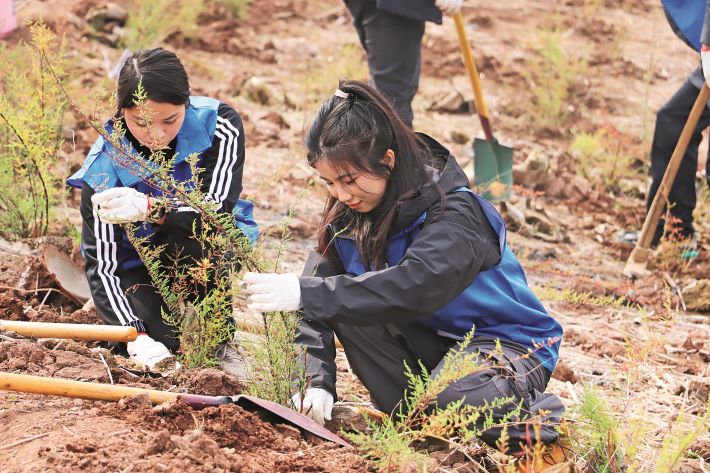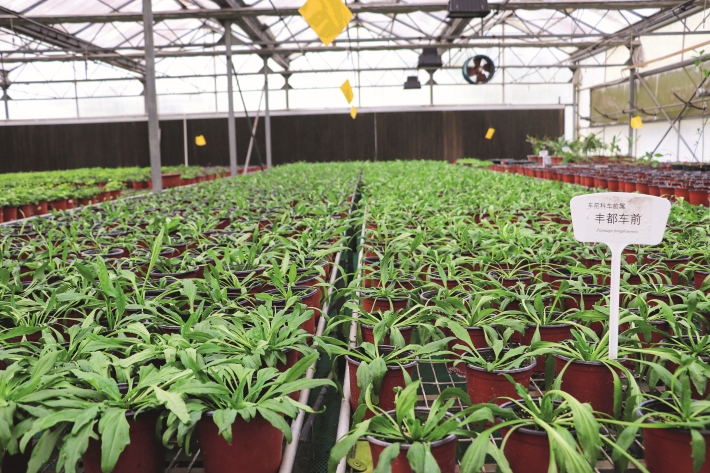|
||||||||||
| Home Nation World Business Opinion Lifestyle ChinAfrica Multimedia Columnists Documents Special Reports |
|
||||||||||
| Home Nation World Business Opinion Lifestyle ChinAfrica Multimedia Columnists Documents Special Reports |
| ChinAfrica |
| Sowing for a Green Future |
| Technology helps rare plant species to thrive in the Yangtze River basin |
| By Hu Fan | VOL. 16 April 2024 ·2024-04-03 |

Workers plant Myricaria laxiflora in Three Gorges Reservoir Area in the county of Zigui, Yichang, central China’s Hubei Province, on 12 March (HU FAN)
Students and volunteers participating in a tree-planting activity at an islet in the Yangtze River on 12 March, the National Tree Planting Day, witnessed the return of two rare species to their native habitat. Artificially bred Myricaria laxiflora and Plantago fengdouensis were transplanted on the slopes of the islet.
Located in the county of Zigui, Yichang, Hubei Province of central China, the islet is a typical area affected by the fluctuation of water levels in the Yangtze River. Most of it is immersed in water during the wet season, which lasts for months, and emerges during the dry season. The adverse conditions have made afforestation of such areas a challenging task.
Thanks to the efforts of the Rare Plants Research Institute of Yangtze River, an affiliate of China Three Gorges Corp. (CTG), endangered plant species endemic to the Yangtze River that adapt to such conditions are discovered, bred and transplanted back to the wild. In doing so, the centre aims to not only reinforce the soil and protect the banks of the river, but also restore biodiversity in the Yangtze River Basin.
“We are proud that 560 rare plant species identified in the Three Gorges Reservoir area have all been effectively protected,” Huang Guiyun, head of the institute, told ChinAfrica.

Picture taken on 12 March shows Plantago fengdouensis cultivated in a base of the Rare Plants Research Institute of Yangtze River in Yichang, central China’s Hubei Province (HU FAN)
Return to nature
Among the 2,000 pieces of Plantago fengdouensis planted during the event, 500 were descendants of space-mutation breeding plants, marking the first time the space-breeding species has been reintroduced into the wild.
First discovered in Fengdu County in upstream Chongqing Municipality in 2001, Plantago fengdouensis has a limited distribution area and was once considered extinct in the wild. In 2022, around 4,000 Plantago fengdouensis seeds were taken aboard the Shenzhou-13 manned spacecraft, spending 183 days in the space travel. The 500 pots of Plantago fengdouensis planted on the islet are the second-generation bred from the seeds that travelled back from space.
By sending the seeds into space for possible mutations that could be induced by radiation, the institute hoped to increase the genetic diversity of the species so that they can select varieties with stronger adaptability to reintroduce them into the wild. The use of the space-breeding technology represents the agency’s efforts at innovation in plant conservation.
Established in 2007 as an import arm of CTG’s scientific research system for eco-environmental protection, the institute is dedicated to the investigation and breeding of rare plant species of the Yangtze River and reintroducing them to the wild for ecological restoration. Over the years, it has developed a system of technologies for ecological governance in areas of large water conservation and hydropower projects, and formed one of China’s largest bases for protecting plant species in the Yangtze River.
In recent decades, the institute has rescued and protected over 1,300 species of rare plants endemic to the Yangtze River basin, and overcome breeding challenges of nearly 100 rare plants. They have developed approaches to afforest landforms specific to the region, such as steep slopes formed by taking stones for building the Three Gorges Dam.
Afforesting areas with fluctuating water levels is one of the recent achievements of the institute. To tackle the challenge, they have conducted experiments with an array of more than 20 types of flood-tolerant trees, shrubs, and herbs at different elevations. Over the past four years, they have established a 7,000-square-metre experimental and demonstration area, and achieved a survival rate of over 90 percent for perennial herbaceous plants and 75 percent for flood-tolerant shrubs.
The institute also puts heavy emphasis on the involvement of the younger generations in protecting plants. By activities such as inviting middle school students to experience planting rare species and adopting a seedling of their own, encouraging them to keep observing it, the institute hopes to enhance their awareness of ecological preservation and sustainable development.

Students learn botanic knowledge in the county of Zigui, Yichang, central China’s Hubei Province, on 12 March (HU FAN)
Growing afforestation
CTG’s efforts are a reflection of China’s focus on greening its land. The country has been leading the world in terms of growth of forest resources, accounting for a quarter of the global increase in forest resources in the last two decades.
According to a National Greening Commission report released in March, about 3.99 million hectares of forest were planted in the country in 2023, higher than the 3.83 million hectares of afforestation seen in 2022. Besides, 4.38 million hectares of degraded grassland were restored, and some 1.9 million hectares of sandy and stony land were improved.
The Chinese people are offered more convenient ways to participate in tree planting. According to the report, China’s online greening platforms carried out more than 24,000 activities last year, which attracted nearly 440 million visits, and promoted the establishment of over 1,500 tree-planting bases.
Thick forests provided a substantial source of revenue. Last year, the output value of China’s forestry and grassland industry reached 9.28 trillion yuan (about $1.31 trillion), up 2.3 percent year on year, and more than 2.53 billion trips were recorded in ecotourism, according to the report.
Having worked in plant protection for over two decades, Huang has personally witnessed the improvement of afforestation in China. According to her, as protection efforts intensify, species that were suspected to be extinct start to emerge as observed in their field investigations.
As China’s pioneering player in plant conservation, the institute has a much bigger goal than catering to the protection needs of the Yangtze River. “With the succuss in the Yangtze River basin, we aim to contribute to national endeavour of plant conservation,” Huang said.
|
||
| About Us | Contact Us | Advertise with Us | Subscribe |
| Copyright Beijing Review All rights reserved 京ICP备08005356号-5 京公网安备110102005860号 |